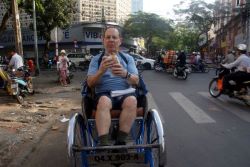January 10
Hello from Hanoi, where we arrived earlier today. It’s quite temperate in this city, which is nearing it’s 1,000th birthday (that’s 1,000) unlike Saigon, which is a mere 300 years old (youngster!), and the political city as Beijing is toward Shanghai. The weather is in the 60s during the day, and the upper 40s or so at night, and that’s Fahrenheit. The locals, though, are in their woolens and down clothing – and it’s not a fashion statement. They think it’s cold, and given their warm summers, they may be right. It doesn’t snow here, and I suspect it’s in the tropics (I’ll check my GPS tomorrow)
As I was out and about this morning (which was free to us), I got up early and walked to the market (the Ben Than market has its counterpart in most Asian cities) – it’s an opportunity to buy almost anything you want – from clothing to groceries, under one roof – including a restaurant and one of my favorite places‚ the wet market (wet because the sellers feature live fish and recently killed chickens, cows, etc.) After 15 minutes of this mayhem, I hired a cyclo (the local type of rickshaw, where you enter kind of a basket and are pedaled around town.
 The persistent Mr. Tom promised me a guided tour for the remaining hour and a half, and took me to places I’d never been before. For around 90 cents, he helped me navigate the purchase of a baguette sandwich (I think it had pork sausage and various other meats) that I’d seen others eating on the street, but not in the hotel. Should be required eating! Only the Vietnamese rival the French for breads! One of the places we visited was an “Army market,” which, near as I could translate from Mr. Tom’s English, had been an Army market under the U.S. days (it was hidden away) and offered the opportunity to buy various Army/Navy surplus items. We also stopped at a pagoda which he said was 150 years old, and it might well have been, before he deposited me back to my hotel so I could pack for the 706-mile ride to Hanoi.
The persistent Mr. Tom promised me a guided tour for the remaining hour and a half, and took me to places I’d never been before. For around 90 cents, he helped me navigate the purchase of a baguette sandwich (I think it had pork sausage and various other meats) that I’d seen others eating on the street, but not in the hotel. Should be required eating! Only the Vietnamese rival the French for breads! One of the places we visited was an “Army market,” which, near as I could translate from Mr. Tom’s English, had been an Army market under the U.S. days (it was hidden away) and offered the opportunity to buy various Army/Navy surplus items. We also stopped at a pagoda which he said was 150 years old, and it might well have been, before he deposited me back to my hotel so I could pack for the 706-mile ride to Hanoi.
As I was pondering deep questions in the cyclo, partly to avoid thinking about the traffic that immersed and swirled around me, I thought about one of the questions I raise in class – about the social responsibilities and the awesome power of multinationals, and I thought I might share my observations of two businesses in Vietnam and what they’ve done to help make the world different/better. This, in the context of an economic downturn in the developed world that has ripple effects in the developing world (the Vietnam Times stories are about – among other things – layoffs in manufacturing and in tourism because of declining demand).
I’ve made the point with some of the Liberal Arts faculty that business support and initiative will be at least as important as individual and volunteer initiative in resolving many social problems. After all, the Bill Gates Foundation gave enough money to inoculate all the children of Vietnam against a few specific diseases.
Here, we went to a grade school outside Bien Hoa, about 2 hours from the Louis Vuitton store in Saigon. The school had been built by Cargill because the government had been too poor to build the school for the children who  would stay too poor without education. It was one of 29 the Cargill Corporation had built, all in the poor rural areas. The company matches the contributions of its employees, suppliers, etc., but has a full time Cargill Activities person, who seeks new opportunities and monitors existing ones.
would stay too poor without education. It was one of 29 the Cargill Corporation had built, all in the poor rural areas. The company matches the contributions of its employees, suppliers, etc., but has a full time Cargill Activities person, who seeks new opportunities and monitors existing ones.
The second example was from AA furniture. The CEO, of whom I’d spoken admiringly, told us that he was converting to the use of “green” wood – and I don’t mean the wood my Scouts use to make fires. There’ s apparently some independent organization that certifies the greenness of wood; he’s been lining up suppliers who meet these approved standards. While he admitted European customers are much more sensitive to the certification than Americans, he stated that he charges no premium for products made from the “green” wood – which is good business and, to me, good conscience.